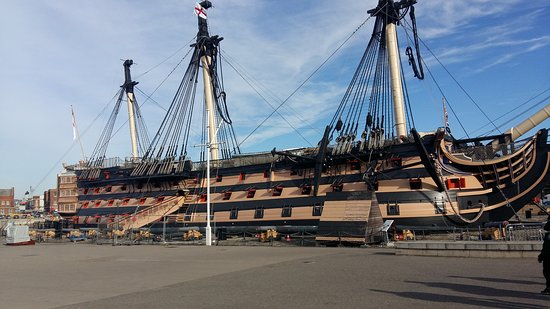A port town on the North Sea with 1,400 years of history, Hartlepool was born around a 7th-century monastery.
By the 19th and early 20th century, Hartlepool had become crucial for its shipbuilding industry and because of this, the town was a victim of a rare bombardment by the Imperial German Navy in 1914. Following the departure of heavy industry, Hartlepool’s harbor has been revitalized with an outdoor quayside museum, where you can visit HMS Trincomalee, the oldest British warship still afloat.
There’s more history at Hartlepool’s Headland, site of that 7th-century monastery, still partially shielded by 14th-century town walls and armed with a Victorian battery.
National Museum of the Royal Navy
Previously called “Hartlepool’s Maritime Experience”, this attraction in Hartlepool’s Marina is a detailed reproduction of a naval seaport from 1800. It will be hard to believe, but up to the 1990s, these were just disused docks for Hartlepool’s former shipbuilding industry.
There are rows of period-style houses, a Guard Room, and Marine Barracks.
In the traditional shops, you’ll see how printers and tailors earned a living.
The sight that will catch your eye immediately is HMS Trincomalee, a genuine frigate launched in Bombay, India in 1817. There’s plenty to keep people of all ages occupied, whether you’re playing an old-time game of skittles on Skittle Square or experiencing the mayhem of a gun battle at sea, while kids can cut loose at the Children’s Maritime Adventure Centre.
Best Buffet Catering Company Hartlepool
HMS Trincomalee
Britain’s oldest warship still afloat, HMS Trincomalee is docked on the Historic Quay at the National Museum of the Royal Navy.
Although this Leda-class sailing frigate is 52 years younger than HMS Victory in Portsmouth, it is still in the water as opposed to Lord Nelson’s flagship, which is in dry dock.
Towed into Hartlepool in a decrepit state in 1987, the ship has become a real emblem for the town after coming through a long-term restoration in 2001. You’ll get to see every inch, from the captain’s cabin to the hold, led by a well-informed guide in period costume, telling stories from when the ship was in an anti-slavery patrol in the mid-19th century.
Before boarding, see the HMS Trincomalee Exhibition, which shows how young men were forcibly recruited or “press-ganged” into the Royal Navy.
The Headland
Thrusting out into the North Sea on the east side of town is Hartlepool’s Headland, composed of magnesian limestone.
One of the UK’s earliest Christian communities, the 7th-century Monastery of St Hilda was found at this very location.
This was ransacked by the Danes around 800 and eventually, the Medieval Church of Hilda was built in its place.
Given its prominent position on the coast, the Headland has long had a defensive role, as you’ll know from the 14th-century town wall and the Victorian Heugh Battery.
Just next door is the Town Moor, scene of the Headland Carnival, which brings more than 100 fairground rides and amusements at the start of August each year.
Heugh Battery Museum
One of three batteries built-in 1860 to prepare Hartlepool for an attack from France, the Heugh Battery is on the eastern tip of the Headland.
At that time Hartlepool was a burgeoning port with a growing shipbuilding industry.
The Heugh Battery has the distinction of being the only British gun battery to have been called into action in the First World War, during a raid on the North East coast by the German Navy during the First World War.
Since closing in 1956 the Heugh Battery has been kept as a museum, open Thursday to Sunday, displaying an excellent weapon and uniform collection in the armory but also showing the inner-workings of a coastal defense.
You can explore the underground magazines and climb up to survey the North Sea from the observation point tower.
Fighting Ships Experience
One of the more recent attractions set up at the National Museum of the Royal Navy, the Fighting Ships Experience reveals the ins and outs of life on board a warship in the year 1800. Conducted around the fictional HMS Prosperity by the ghost of a Powder Monkey (a member of staff in costume), you’ll find out about the grim realities of the Napoleonic Wars.
There are tableaux for the many different corners of this recreated ship, from the gun ports to the officers’ wardroom, with no detail spared on how wounds were treated and how members of the crew were buried at sea.

